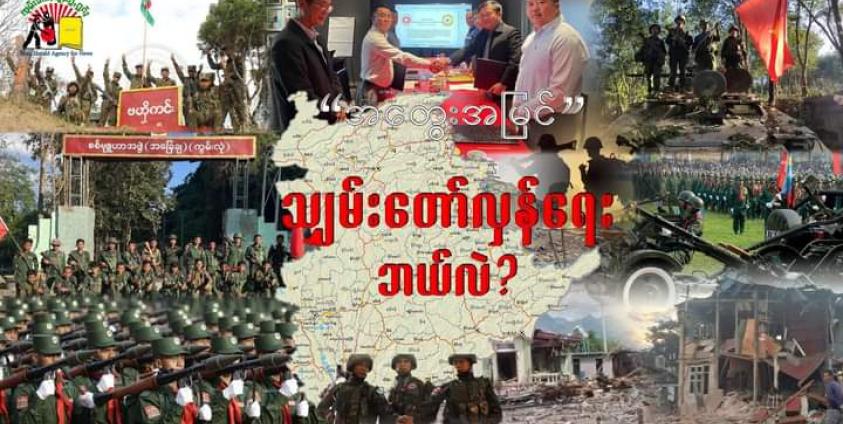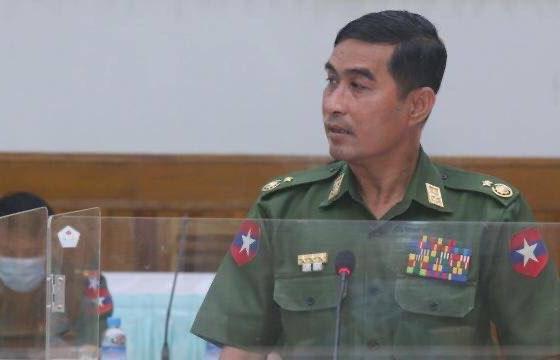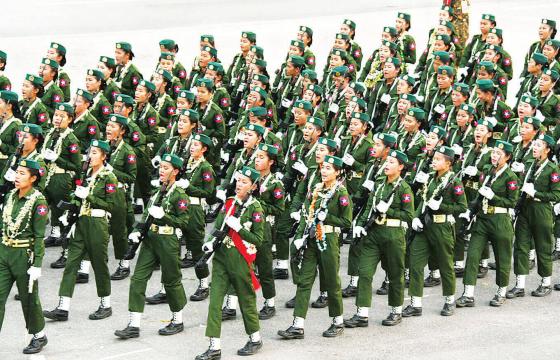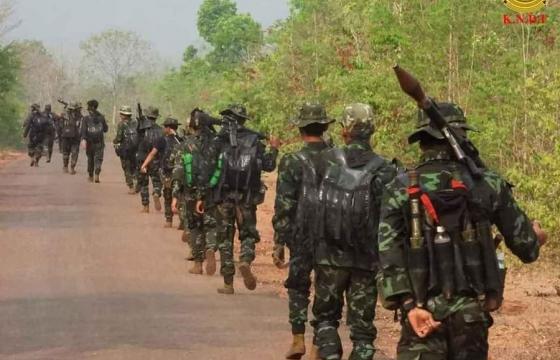Bridges crumble sporadically, mirroring the pervasive destruction.The remnants of war- ravaged homes stretch across the horizon. Over the past 60 days,the resistance forces' offensive has steadily gained momentum, marked by a series of notable successes.
In a span of over 60 years of rule, a series of Juntas, commencing with a coup in 1962 under the pretext of unifying the nation, instituted a system of brutal military rule to govern and oppress the entire populace. Today this infamously brutal regime finds itself grappling with unprecedented challenges and facing the potential collapse of their coup-regime.
Surprisinglynone of the powerful Shan ethnic armed organizations (EAOs), who used to be so vocal about fighting for the liberation of the 5 million Shan population, have actively participated in 'Operation 1027', by far the biggest -ever challenge to the Junta troops stationed in Shan State since the 1960s.
The biggest Shan EAOs are now strangely have gone “missing”,at time when so many civilians are cheering the revolutionary movement that is sweeping through northern Shan State, forcing mass surrenders, capturing bases and destroying the morale of the armed forces that has for so long oppressed the Shan people.
Revolution in northern Shan State
In Northern Shan State, where the majority of the Shan people reside, the forefront of the resistance warfare inflicting deep wounds upon the Military Council is led by EAOs representing the Kokang, with a population of less than 200,000, and the Ta'ang (Palaung) ethnic groups, numbering around 700,000.
Other EAOs and resistance forces, such as the Kachin Independence Army (KIA), Arakan Army (AA), Bamar People's Liberation Army (BPLA), Karenni Nationalities Defense Force (KNDF), and People's Defense Force (PDF), although not primarily based in Shan State, are actively engaged in the northern Shan Statebattlefield.
In the midst of ethnically diverse resistance forces delivering substantial blows against the Junta in northern Shan State, the Shan EAOs envelop themselves in an excessive silence, creating the impression as if they never existed at all.
Ceasefire between Shan EAOs
 As the Three Brotherhood Alliance launched initiated 'Operation 1027' on October 27th,the ShanEthnic Armed Organizations (EAOs) initially maintained silence.However on November 29th, a statement was issued indicating that a ceasefire had been agreed upon between the two influential Shan EAOs.The two Shan forces:
As the Three Brotherhood Alliance launched initiated 'Operation 1027' on October 27th,the ShanEthnic Armed Organizations (EAOs) initially maintained silence.However on November 29th, a statement was issued indicating that a ceasefire had been agreed upon between the two influential Shan EAOs.The two Shan forces:
The Restoration Council ofShan State / Shan State Army – South(RCSS/SSA-S) and Shan State Progress Party / Shan State Army – North (SSPP/SSA-N ).
It is noteworthy that the announcement of a ceasefire between the two Shan EAOs, frequently involved in clashes, brings positive news for the Shan community, offering a sense of relief
Conversely, it is essential to underscore that this development also constitutes a historical embarrassment, vividly illuminating the lack of unity among leaders within the Shan resistance movement.
Is there unity among Shan people?
Throughout the history of the Shan resistance movement, a recurring theme has been the prevalence of internal divisions and a lack of unity among the Shan resistance forces, marked by numerous instances of hostility. The Shan EAOs have not only been entangled in conflicts with each other but have also engaged in warfare with other ethnic EAOs based in Shan State.
The necessity for the two Shan EAOs the RCSS and the SSPP to declare a ceasefire underscores the prior lack of unity between them. As the new generation and civil society questions why these factionsengage in sectarian warfare against each other despite sharing a common adversary, the Shan EAOs should reflect on whether they can provide a rational answer to this question?
Revolution belongs to people
Without strong public support, the revolution would amount to little more than the daydreams of a small faction. However, for over 60 years, the Shan people have taken on a significant responsibility, unmistakably show-casing their fervent aspiration to liberate themselves from military rule. Numerous beloved children of the Shan people have made profound sacrifices in need of the revolutionary cause.
The Shan people continue to shoulder the material demands of the revolution beyond their means. Every parent aspires to ensure the freedom of future generations.Yetfor over six decades, the ethnic Shan resistance movement has failed to yield any tangible results commensurate with the sacrifices made by generations.
Centre of Shan politics
While there may be various fundamental reasons for wars, one of the most basic factors is territorial disputes.Throughout the Shan resistance struggle, clashes have arisen between different ethnic groups in Shan State for various reasons, with the primary issue revolving around the dispute over the control of areas that are yet to be liberated.
The ongoing clashes in northern Shan State are unfolding over historically important Shan territories.If the entire northern Shan State comes under the control of the Three Brotherhood Alliance and is liberated from military rule, the looming question of governance in those areas will undoubtedly become a significant area of potentially contentious debate.
If only the Shan Ethnic Armed Organizations (EAOs) had taken the lead in the territory-capturing operations, this problem could have been easily resolved. Now however, it seems to be too late.
"Strategy without tactics is the slowest route to victory. Tactics without strategy are the noise before the defeat," wrote the Chinese philosopher and strategist Sun Tzu in his military treatise, Art of War, approximately 2500 years ago.
Without prior resolution of territorial issues in dispute, and a political agreement of 1027 Brotherhood Alliance which includes the Shan EAOs, This could potentially lead to re- intervention by Naypyidaw-based generals, to thwart the revolutionary movement.
EAOs should not be for a few
 Recognizing that Shan EAOs are constructed through the collective efforts of the people involving their sweat, tears and financial contributions, the leaders of these entities must refrain from using them for personal gain.
Recognizing that Shan EAOs are constructed through the collective efforts of the people involving their sweat, tears and financial contributions, the leaders of these entities must refrain from using them for personal gain.
The Shan people do not need leaders who hastily fly to Naypyidaw, humbly bowing and sycophantically appeasing the Junta on every occasion, summoned by the coup regime. Nor do they require leaders who are inactive and hesitant during opportune times to fight for freedom.
If the unyielding aspiration is for Shan State to break free from the grip of military dictators, those presently at the helm of the revolution should relinquish power without clinging to the limited authority they possess, entrusting it to young leaders who can proficiently advance the revolutionary cause.
The tears of our mothers have overflowed more than the flood waters of the Ayeyarwady River. The grinding sound of teeth, resonant with the fathers' resentment, echoed louder than thunder.They all sacrificed greatly during the arduous journey of the Shan revolution struggle, spanning over 60 tumultuous years marked by turbulent phases and roller-coaster-like ups and downs. They rightfully deserve a meaningful outcome, yet the attainment of such a result remains a mystery.
Historically Shan political organizations have occupied a central role in the political landscape of Shan State. But they are surrounded by political factions representing other ethnicities that share the region with them.
The current period can be aptly described as an era of all-out war nationwide. This reality dictates that the potential for solutions through purely political means is automatically very weak and scope for dialogue with the regime all but eliminated by the 2021 coup.
However The Restoration Council of Shan State (RCSS) appears to stuck in a time-warp. In their annual conference January 24- 26th2024 they reiterated the same old statements about dialogue.In response to Myanmar’s political crisis, the RCSS stated.”The RCSS we will persist in our endeavors to address the situation by engaging in dialogue and discussion.” ( Note BNI editors have added this reference to the RCSS conference which took place after this feature was submitted on January 8th) If the Shan resistance forces had chosen to take on a leading role in the all-out war, a Shan-centric focus could have endured. However, the Shan Ethnic Armed Organizations (EAOs) have opted to avoid the conflict, inevitably confronting the deserved political consequence of becoming irrelevant by sitting out the conflict raging in their midst.
It is bewildering why the individuals who proclaimed themselves as leaders of the Shan resistance movement displayed hesitancy and lack-luster commitment when presented with this prime opportunity to participate in dismantling the military dictatorship.







